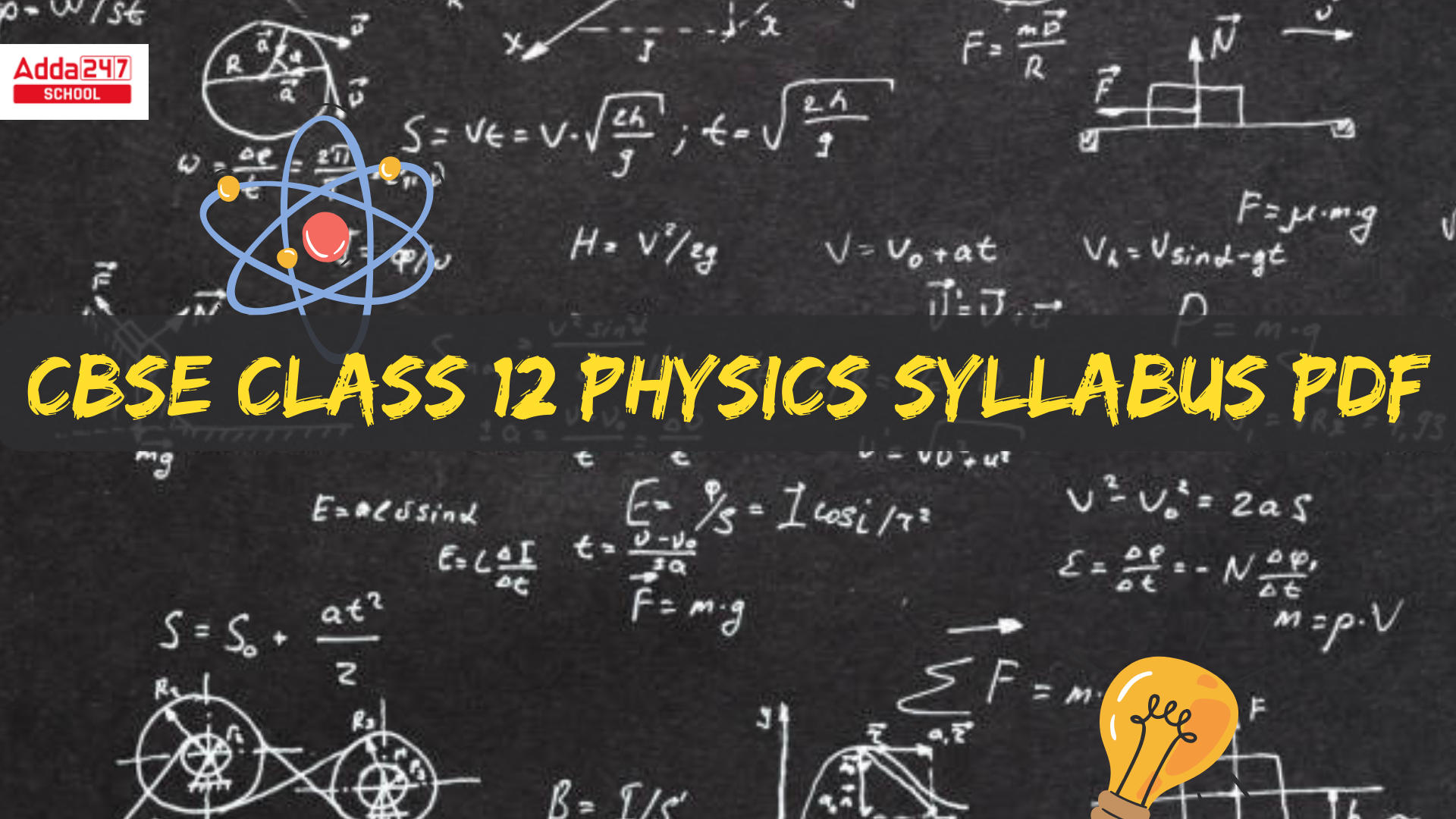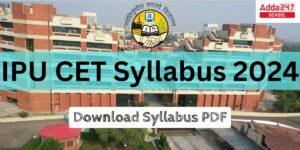Table of Contents
CBSE Class 12 Physics Syllabus 2023-24: The Central Board of Secondary Education has released the Physics Syllabus Class 12 CBSE 2023-24 on the official site for 2023-2024 academic year. The Physics Syllabus Class 12 CBSE 2023-24 is intended to emphasize a fundamental conceptual understanding of Physics, the use of SI units and symbols, the nomenclature of physical quantities and international standards, logical sequencing of subject matter units, and others.
Physics class 12 syllabus 2023 24 official pdf includes the course structure, course materials, question types, and so on. CBSE Class 12 students are advised to have a thorough understanding of the Physics syllabus and to download the CBSE Class 12 Physics Syllabus 2023-24 PDF from this article.
Class 12 Physics Syllabus 2023-24
The Class 12 Physics syllabus 2023-24 is a thorough and demanding curriculum that covers a wide range of physics topics. The class 12 physics syllabus 2023-24 is intended to equip students with a solid foundation in fundamental physics ideas as well as a grasp of current advances in the discipline. The curriculum also contains a practical component that allows students to apply their physics knowledge to real-world activities.
Physics Syllabus Class 12 CBSE 2023-24 -Marks Breakup
The table below consists of Marks’s breakup of the physics syllabus Class 12 CBSE 2023-24.
| Subject | Physics |
|---|---|
| Subject Code | 041 |
| Marks Breakup | Total = 100 |
| Theory 70 | |
| Practical 30 |
Physics Class 12 Syllabus 2023-24: Course structure
The physics class 12 syllabus 2023 24 is an excellent resource for students who want to work in sociology, social work, or other related subjects. Students will learn the abilities they need to excel in these industries by understanding the material in the syllabus.
The table below consists of the course structure of the syllabus of physics class 12 cbse 2023-24.
| Units | Name of the unit | Marks |
| Unit–I | Electrostatics | 16 |
| Chapter–1: Electric Charges and Fields | ||
| Chapter–2: Electrostatic Potential and Capacitance | ||
|
Unit-II |
Current Electricity | |
| Chapter–3: Current Electricity | ||
|
Unit-III |
Magnetic Effects of Current and Magnetism | 17 |
| Chapter–4: Moving Charges and Magnetism | ||
| Chapter–5: Magnetism and Matter | ||
| Unit-IV | Electromagnetic Induction and Alternating Currents | |
| Chapter–6: Electromagnetic Induction | ||
| Chapter–7: Alternating Current | ||
| Unit–V | Electromagnetic Waves | 18 |
| Chapter–8: Electromagnetic Waves | ||
| Unit–VI | Optics | |
| Chapter–9: Ray Optics and Optical Instruments | ||
| Chapter–10: Wave Optics | ||
| Unit–VII | Dual Nature of Radiation and Matter | 12 |
| Chapter–11: Dual Nature of Radiation and
Matter |
||
| Unit–VIII | Atoms and Nuclei | |
| Chapter–12: Atoms | ||
| Chapter–13: Nuclei | ||
| Unit–IX | Electronic Devices | 7 |
| Chapter–14: Semiconductor Electronics: Materials, Devices and Simple Circuits | ||
| Total | 70 | |
| Practicals | 30 | |
| Total | 100 | |
Syllabus of Physics Class 12 CBSE 2023-24: Question paper design
The table below consists of the question paper design of Syllabus of Physics Class 12 CBSE 2023-24.
| Typology of Questions | Total Marks | Approximate % |
| Remembering: Exhibit memory of previously learned material by recalling facts, terms, basic concepts, and answers.
Understanding: Demonstrate understanding of facts and ideas by organising, comparing, translating, interpreting, giving descriptions, and stating main ideas. |
27 | 38 |
| Applying: Solve problems in new situations by applying acquired knowledge, facts, techniques and rules in a different way. | 22 | 32 |
| Analysing: Examine and break information into parts by identifying motives or causes. Make inferences and find evidence to support generalisations.
Evaluating: Present and defend opinions by making judgments about information, validity of ideas, or quality of work based on a set of criteria. Creating: Compile information together in a different way by combining elements in a new pattern or proposing alternative solutions. |
21 | 30 |
| Total | 70 | 100 |
| Practical | 30 | |
| Gross Total | 100 |
CBSE physics syllabus 2023-24: Unit-wise
Detailed Unit wise cbse physics syllabus 2023-24 is given below.
Class 12 Physics Syllabus 2023-24 Unit 1: Electrostatics
Chapter 1: Electric Charges and Fields
Electric charges, Conservation of charge, Coulomb’s law force between two point charges, forces between multiple charges; superposition principle and continuous charge distribution electric field, electric field due to a point charge, electric field lines, electric dipole, electric field due to a dipole, torque on a dipole in a uniform electric field.Electric flux, statement of Gauss’s theorem and its applications to find field due to infinitely long straight wire, uniformly charged infinite plane sheet and uniformly charged thin spherical shell (field inside and outside).
Chapter 2: Electrostatic Potential and Capacitance
Electric potential, potential difference, electric potential due to a point charge, a dipole and system of charges; equipotential surfaces, electrical potential energy of a system of two point charges and electric dipole in an electrostatic field.
Conductors and insulators, free charges and bound charges inside a conductor. Dielectrics and electric polarization, capacitors and capacitance, combination of capacitors in series and parallel, capacitance of a parallel plate capacitor with and without dielectric medium between the plates, energy stored in a capacitor (no derivation, formulae only).
Class 12 Physics Syllabus 2023-24 Unit 2 :Current Electricity
Chapter 3: Current Electricity
Electric current, the flow of electric charges in a metallic conductor, drift velocity, mobility and their relation with electric current; Ohm’s law, V-I characteristics (linear and non-linear), electrical energy and power, electrical resistivity and conductivity, the temperature dependence of resistance, Internal resistance of a cell, potential difference and emf of a cell, a combination of cells in series and parallel, Kirchhoff’s rules, Wheatstone bridge
Class 12 Physics Syllabus 2023-24 Unit 3:Magnetic Effects of Current and Magnetism
Chapter 4: Moving Charges and Magnetism
Concept of the magnetic field, Oersted’s experiment.
Biot – Savart law and its application to the current carrying circular loop.
Ampere’s law and its applications to infinitely long straight wire. Straight solenoid (only qualitative treatment), force on a moving charge in uniform magnetic and electric fields.
Force on a current-carrying conductor in a uniform magnetic field, the force between two parallel current-carrying conductors-definition of an ampere, torque experienced by a current loop in a uniform magnetic field; Current loop as a magnetic dipole and its magnetic dipole moment, moving coil galvanometers current sensitivity and conversion to ammeter and voltmeter.
Chapter 5: Magnetism and Matter
Bar magnet, bar magnet as an equivalent solenoid (qualitative treatment only), magnetic field intensity due to a magnetic dipole (bar magnet) along its axis and perpendicular to its axis (qualitative treatment only), torque on a magnetic dipole (bar magnet) in a uniform magnetic field (qualitative treatment only), magnetic field lines.
Magnetic properties of materials- Para-, dia- and ferromagnetic substances with examples, Magnetization of materials, the effect of temperature on magnetic properties.
Class 12 Physics Syllabus 2023-24 Unit 4:Electromagnetic Induction and Alternating Currents
Chapter 6: Electromagnetic Induction
Electromagnetic induction; Faraday’s laws, induced EMF and current; Lenz’s Law, Self and mutual induction.
Chapter 7: Alternating Current
Alternating currents, peak and RMS value of alternating current/voltage; reactance and impedance; LCR series circuit (phasors only), resonance, power in AC circuits, power factor, wattless current. AC generator, Transformer.
Class 12 Physics Syllabus 2023-24 Unit 5:Electrostatics
Chapter 8: Electromagnetic Waves
The basic idea of displacement current, Electromagnetic waves, their characteristics, and their transverse nature (qualitative idea only). Electromagnetic spectrum (radio waves, microwaves, infrared, visible, ultraviolet, X-rays, gamma rays) including elementary facts about their uses.
Class 12 Physics Syllabus 2023-24 Unit 6: Optics
Chapter 9: Ray Optics and Optical Instruments
Ray Optics: Reflection of light, spherical mirrors, mirror formula, refraction of light, total internal reflection and optical fibres, refraction at spherical surfaces, lenses, thin lens formula, lens maker’s formula, magnification, power of a lens, combination of thin lenses in contact, refraction of light through a prism.
Optical instruments: Microscopes and astronomical telescopes (reflecting and refracting) and their magnifying powers.
Chapter 10: Wave Optics
Wave optics: Wave front and Huygens principle, reflection and refraction of plane wave at a plane surface using wave fronts. Proof of laws of reflection and refraction using Huygens principle. Interference, Young’s double slit experiment and expression for fringe width (No derivation final expression only), coherent sources and sustained interference of light, diffraction due to a single slit, and width of central maxima (qualitative treatment only).
Unit 7:Dual Nature of Radiation and Matter
Chapter 11: Dual Nature of Radiation and Matter
Dual nature of radiation, Photoelectric effect, Hertz and Lenard’s observations; Einstein’s photoelectric equation-particle nature of light.Experimental study of photoelectric effectMatter waves-wave nature of particles, de-Broglie relation.
Class 12 Physics Syllabus 2023-24 Unit 8 : Atoms and Nuclei
Chapter 12: Atoms
Alpha-particle scattering experiment; Rutherford’s model of atom; Bohr model of the hydrogen atom, Expression for the radius of the nth possible orbit, velocity and energy of an electron in his orbit, of hydrogen line spectra (qualitative treatment only).
Chapter 13: Nuclei
Composition and size of nucleus, nuclear forceMass-energy relation, mass defect; binding energy per nucleon and its variation with mass number; nuclear fission, nuclear fusion.
Class 12 Physics Syllabus 2023-24 Unit 9:Electronic Devices
Chapter 14: Semiconductor Electronics: Materials, Devices and Simple Circuits
Energy bands in conductors, semiconductors and insulators (qualitative ideas only) Intrinsic and extrinsic semiconductors- p and n-type, p-n junction Semiconductor diode – I-V characteristics in forward and reverse bias, application of junction diode -diode as a rectifier.
CBSE Class 12 Physics Syllabus 2023-24 PDF
The CBSE Class 12 Physics syllabus 2023-24 is demanding and difficult, but it is also rewarding. Students will gain the skills and knowledge they need to succeed in their academics and beyond by completing this cbse class 12 physics syllabus 2023-24.
| CBSE class 12 physics syllabus 2023-24 PDF Download Link |
| Physics Syllabus Class 12 CBSE 2023-24 PDF |
Physics Class 12 Practical Syllabus 2024
Experiments for Class 12 Practical:
Section A.
- To determine resistivity of two or three wires, plot a graph of potential difference versus current.
- To determine the resistance of a given wire or standard resistor using a metre bridge.
- To test the laws of resistance combination (series) with a metre bridge.
OR - To verify the laws of resistance combination (parallel) using a metre bridge.
- Determine the resistance of a galvanometer using the half-deflection method and calculate its figure of merit.
- To convert the given galvanometer (of known resistance and figure of merit) into a voltmeter with the desired range and verify it.
OR - To convert the given galvanometer (with known resistance and figure of merit) into an ammeter of the desired range
- To transform the given galvanometer (with known resistance and figure of merit) into an ammeter of the desired range and verify the result.
- To determine the frequency of the AC mains using a sonometer.
CBSE Class 12 Physics Practical: Assigned Practicals
- To determine the resistance and impedance of an inductor, with or without an iron core.
- Use a multimeter to measure resistance, voltage (AC/DC), current (AC), and circuit continuity.
- To create a household circuit that includes three bulbs, three (on/off) switches, a fuse, and a power source.
- To put together the components of a given electrical circuit.
- To investigate the variation in potential drop with the length of a wire for a constant current.
- To draw a diagram of an open circuit that includes at least a battery, resistor/rheostat, key, ammeter, and voltmeter. Mark any components that are not connected in the proper order and correct both the circuit and the circuit diagram.
Experiments for Class 12 Practical:
Section B.
- Determine the value of v for various u values in the case of a concave mirror, as well as the focal length.
- To determine the focal length of a convex mirror, use a convex lens.
- To determine the focal length of a convex lens, plot graphs between u and v or 1/u and 1/v.
- To determine the focal length of a convex mirror, use a convex lens.
- To calculate the angle of minimum deviation for a given prism, plot a graph of the angle of incidence and angle of deviation.
- Using a traveling microscope, determine the refractive index of a glass slab.
- To determine a liquid’s refractive index, use a convex lens and a plane mirror.
- To determine the refractive index of a liquid, use a concave mirror and a plane mirror.
- Draw the I-V characteristic curve for a p-n junction in both forward and reverse bias.
CBSE Syllabus for Class 12 Physics Assigned Practical
- To distinguish a diode, an LED, a resistor, and a capacitor from a mixed collection of similar items.
- Use a multimeter to see the unidirectional flow of current in the case of a diode and an LED, as well as to determine whether a given electronic component (for example, a diode) is operational.
- Observe light diffraction caused by a thin slit.
- To investigate the nature and size of the image formed by a (i) convex lens and (ii) concave mirror on a screen using a candle and a screen (at various distances from the lens/mirror).
- To investigate the effect of light intensity (via varying distance from the source) on an LDR.
- To observe the refraction and lateral deviation of a light beam incident obliquely on a glass slab.
- To create a lens combination with the specified focal length using two lenses from the given set of lenses.



 IPU CET Syllabus 2024- Indraprastha Univ...
IPU CET Syllabus 2024- Indraprastha Univ...
 MHT CET Syllabus 2024 with Chapter wise ...
MHT CET Syllabus 2024 with Chapter wise ...
 AP EAMCET Syllabus 2024- MPC and BiPC Su...
AP EAMCET Syllabus 2024- MPC and BiPC Su...















